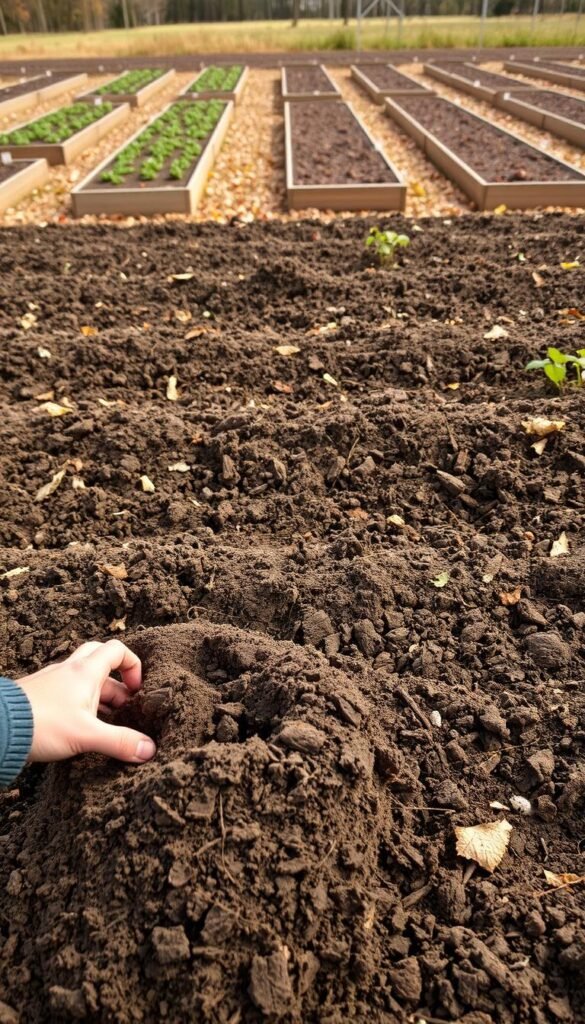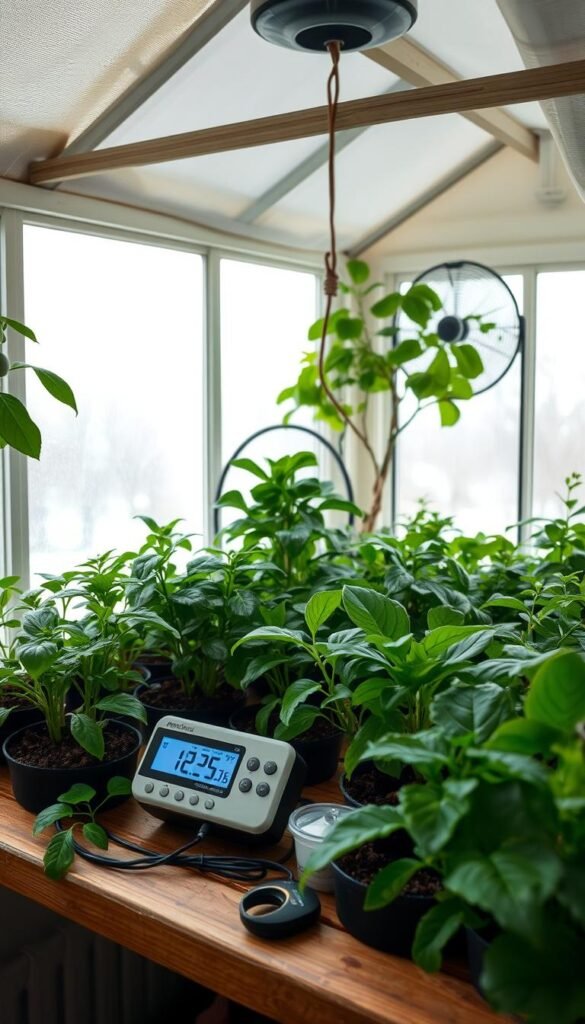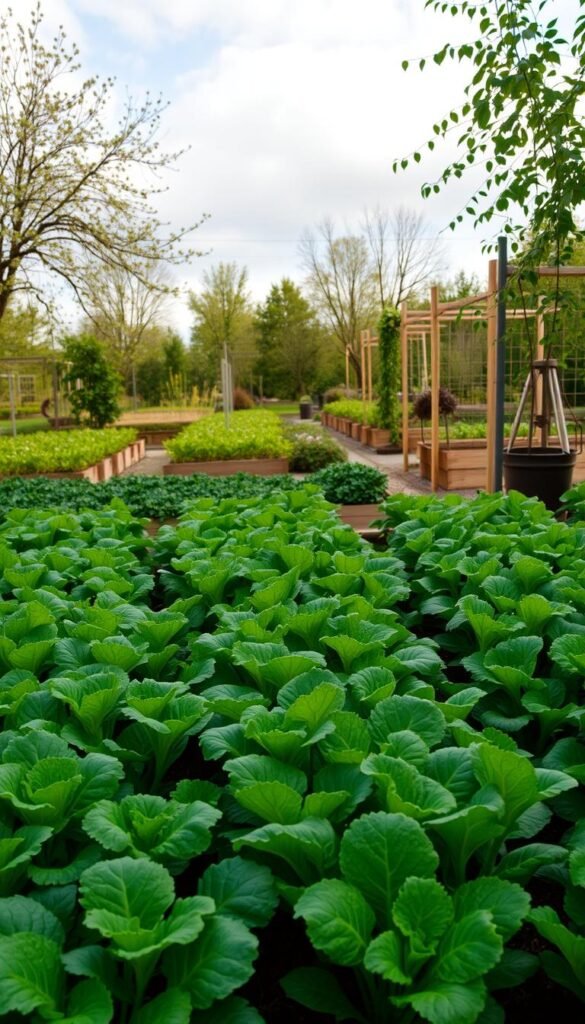Did you know your backyard can thrive even as temperatures drop? With the right approach, chilly months become an opportunity to grow crisp, nutrient-packed greens. Horticulturist Deborah Miuccio notes that properly selected plants can yield up to 30% more produce compared to spring-only harvests.
Choosing frost-tolerant varieties lets you enjoy fresh meals straight from your plot long after summer ends. These resilient greens not only survive light freezes but often develop sweeter flavors in cooler conditions. Imagine snipping vibrant kale for soups or adding peppery arugula to salads while neighbors’ gardens lie dormant.
Strategic planning turns challenges like early snowfall into manageable hurdles. Simple techniques – from row covers to mulch layers – protect roots and leaves. You’ll discover how timing plantings and selecting regional favorites keeps your soil productive through seasonal shifts.
Ready to transform frosty mornings into harvest opportunities? Below, we’ll share proven strategies for maximizing yields and extending your growing calendar. Let’s explore which varieties thrive in your climate and how to nurture them through nature’s chilliest phases.
Understanding Winter Vegetable Gardening

What if your garden didn’t hibernate when the mercury dips? Cooler months offer unique advantages you might miss during warmer seasons. Frost-kissed greens like spinach develop richer flavors, while root crops store energy for sweeter yields – nature’s way of rewarding your efforts.
Why Try Winter Gardening?
Shorter days trigger sugar production in leafy greens, making them tastier than their summer counterparts. You’ll also dodge common pests that vanish after first frosts. Research from the University of Vermont shows kale grown in chilly weather contains 20% more antioxidants than spring-harvested leaves.
Key Benefits for Your Garden and Well-Being
Growing during off-peak months lets you rotate crops efficiently, preventing soil depletion. Instead of staring at empty beds, you’re building healthier earth for next year’s tomatoes. Plus, spending 30 minutes daily among plants reduces stress hormones by 40%, according to a 2023 NIH study.
| Factor | Cold-Season Growth | Warm-Season Growth |
|---|---|---|
| Flavor Development | Sweeter, concentrated tastes | Milder profiles |
| Pest Pressure | Minimal insect activity | High infestation risks |
| Water Needs | Reduced evaporation | Frequent irrigation |
| Harvest Duration | Weeks-long picking windows | Short peak ripeness |
This seasonal shift isn’t just about fresh salads – it’s a chance to reconnect with nature’s rhythms. You’ll gain pride nurturing life through frosty mornings while neighbors’ plots sit empty. Ready to discover which plants thrive in your area’s chill?
Selecting the Best Cold-Hardy Crops

Ever wonder which greens laugh at frost? Certain edibles not only survive icy nights but actually improve their texture and taste. Let’s explore varieties that turn chilly weather into a flavor-enhancing superpower.
Featured Vegetables for a Winter Harvest
Brussels sprouts sweeten after light freezes, while turnips store sugars in their roots for earthy-sweet roasts. Beets handle temperatures down to 30°F, developing deeper hues and richer flavors. Their leafy tops add color to soups long after snowfall.
| Crop | Frost Tolerance | Planting Window | Harvest Tip |
|---|---|---|---|
| Kale | Down to 20°F | 6-8 weeks before first frost | Pick outer leaves first |
| Carrots | Survives 15°F | Late summer | Mulch with straw |
| Cabbage | Handles 25°F | Midsummer starts | Wrap heads for storage |
| Broccoli | Thrives at 28°F | Early fall transplants | Cut main head first |
Spinach grows fastest when days cool, offering multiple cuttings before dormancy. Master gardener Linda Ly suggests covering root crops with shredded leaves – this natural blanket prevents ground freeze while boosting nutrient retention.
These kitchen heroes shine in diverse dishes. Roast cabbage wedges with apples, blend beet greens into pesto, or shred broccoli stems for slaw. Their resilience means fresh meals even when thermometers plummet.
Preparing Your Garden Soil for Winter Vegetables

What’s the secret ingredient for thriving edibles when frost arrives? Healthy soil acts like a cozy blanket for roots, storing nutrients and warmth. Start by understanding your ground’s unique needs – this knowledge transforms sparse yields into abundant harvests.
Soil Testing and Nutrient Amendments
Grab a testing kit from your local extension office or garden center. Experts at Penn State recommend sampling 5-6 spots in your plot, mixing them for an accurate report. Results reveal pH levels and missing minerals – key data for choosing amendments.
Most leafy greens prefer slightly acidic ground (6.0-6.8 pH). If your numbers fall outside this range, add lime to raise alkalinity or sulfur to increase acidity. Balanced soil helps plants absorb nutrients efficiently, even in chilly conditions.
| Amendment | Purpose | Application Time |
|---|---|---|
| Composted manure | Boosts nitrogen | 4 weeks before planting |
| Bone meal | Strengthens roots | At transplanting |
| Greensand | Adds potassium | Fall or spring |
Embracing the Benefits of Compost
Mix 2-3 inches of finished compost into your ground to improve texture and water retention. This organic gold releases nutrients slowly, feeding plants through gradual decomposition. University studies show compost-enriched soil retains 40% more moisture – crucial during dry winter spells.
Top-dress beds with straw or shredded leaves after planting. This mulch layer insulates against temperature swings while suppressing weeds. Your plants’ roots stay protected, letting them focus energy on producing crisp leaves and sturdy stems.
Starting Seeds Indoors for a Winter Head Start
Imagine plucking fresh greens weeks earlier than outdoor-sown plants. Indoor seed starting gives frost-tolerant varieties the strong foundation they need before facing chilly conditions. This method lets you control temperature and light, ensuring vigorous growth from day one.
Why Soil Blocking Makes Sense
Traditional plastic pots often stunt root growth. Soil blocking solves this by creating dense, self-contained cubes from nutrient-rich soil mixtures. These blocks eliminate transplant shock since seedlings go straight into garden beds without disturbing delicate roots.
| Method | Root Health | Success Rate |
|---|---|---|
| Soil Blocks | Unrestricted growth | 92% survival |
| Plastic Pots | Circling roots | 78% survival |
Mix equal parts compost, peat moss, and vermiculite for ideal blocks. Press the damp blend into a mold, then nestle seeds into each cube’s dimple. Within days, you’ll see sprouts reaching for your grow lights.
Follow these steps for thriving seedlings:
- Position lights 2-4 inches above sprouts
- Water blocks from the bottom to prevent erosion
- Rotate trays daily for even growth
Healthy starts handle temperature drops better later. Your careful indoor work means plants hit the ground running when transplanted, shrugging off frosty nights with ease.
Using Protective Covers and Greenhouse Techniques

What if you could stretch your harvest weeks past the first frost? Protective structures create microclimates that shield plants while letting sunlight work its magic. Deborah Miuccio compares these tools to “weather armor” – they defend against ice while trapping precious warmth.
High Tunnels, Row Covers, and Cloches Explained
High tunnels – those curved-frame greenhouses – offer the most robust protection. Jim Myers from Oregon State University found they raise soil temps by 10-15°F, letting spinach thrive through December. These tunnels excel for larger plots, giving you room to grow multiple rows of greens.
Floating row covers act like breathable blankets. Made from lightweight fabric, they guard against frost while letting rain through. Drape them directly over plants or support them with hoops. For single specimens like cabbage, bell-shaped cloches create personal greenhouses using recycled milk jugs or glass domes.
| Protection Type | Temp Boost | Best For | Setup Tip |
|---|---|---|---|
| High Tunnels | +15°F | Large-scale plots | Anchor frames securely |
| Row Covers | +6-8°F | Quick frost defense | Use clips, not rocks |
| Cloches | +4-5°F | Individual plants | Vent on sunny days |
Choose based on your garden’s size and local chill factors. Coastal areas might opt for row covers, while mountain growers often need tunnels. One Vermont gardener reported harvesting carrots in January using layered fabric over a low tunnel – proof these methods work.
Set up success with three steps:
- Install structures before ground freezes
- Secure edges with soil or sandbags
- Monitor humidity weekly
These techniques turn fleeting seasons into extended feasts. Your arugula will thank you with extra handfuls for winter salads.
Timing Your Winter Planting Schedule

When’s the perfect moment to get those resilient greens in the ground? Timing makes all the difference between thriving plants and frostbitten disappointments. Start by tracking your area’s average first frost date – this anchor point determines when to sow seeds or transplant seedlings.
Mastering the Hardening-Off Process
Young plants need tough love before facing the elements. Begin exposing indoor-started seedlings to outdoor conditions 2-3 weeks before transplanting. Start with 1-hour shaded sessions, gradually increasing to full-day sun over 7-10 days. Cornell researchers found this method reduces transplant shock by 65% compared to abrupt moves.
Planning Succession Planting for Continuous Harvest
Stagger your sowing like a pro chef timing dinner courses. Every 2-3 weeks, add new rows of fast-growers like radishes or spinach. Pair them with slower varieties like Brussels sprouts that mature over months. This table keeps your kitchen stocked:
| Crop Type | Planting Interval | Days to Harvest |
|---|---|---|
| Leafy Greens | Every 14 days | 28-40 |
| Root Vegetables | Every 21 days | 50-70 |
| Cabbage Family | Single planting | 90-120 |
Adjust dates using your first frost as a countdown clock. For example, if kale needs 60 days to mature, work backward from that initial freeze marker. Protective covers buy extra weeks if unexpected cold arrives early.
Watering and Mulching Strategies for Cold Weather

Your plants’ survival through frosty nights depends on two unsung heroes: water and mulch. Proper hydration prevents root damage when temperatures plunge, while organic blankets shield soil from harsh conditions. Let’s explore how these elements work together to keep edibles thriving.
Water deeply before expected freezes. Moist soil holds heat better than dry earth, protecting roots from sudden chills. Aim for morning irrigation so excess moisture evaporates before nightfall. Check forecasts weekly – reduce frequency if precipitation is predicted.
Mulch acts like a thermostat for your garden beds. A 3-4 inch layer:
- Slows soil temperature swings
- Blocks drying winds
- Suppresses weed competition
| Mulch Type | Insulation Value | Moisture Retention | Best For |
|---|---|---|---|
| Straw | High | Moderate | Root crops |
| Shredded leaves | Medium | High | Leafy greens |
| Wood chips | Low | Low | Pathways |
Adjust your approach based on local conditions. Sandy soils need thicker mulch than clay-heavy earth. For container setups, wrap pots with burlap after mulching. This double layer prevents soil freeze-thaw cycles that heave plants upward.
Follow this 3-step routine:
- Water beds 24 hours before frost
- Apply mulch after soil cools below 50°F
- Refresh layers after heavy rains
These simple moves create stable growing conditions. Your plants will reward you with steady growth despite the mercury’s dance.
Nurturing Your Indoor and Outdoor Winter Garden

Balancing light and warmth transforms chilly days into growth opportunities. Whether tending seedlings indoors or protecting mature plants outside, smart environmental control keeps your greens thriving. Modern tools bridge the gap between nature’s limits and your harvest goals.
Mastering Light and Heat Balance
Indoor setups need 14-16 hours of daily light during darker months. LED grow lights positioned 6 inches above plants mimic sunlight without overheating leaves. Pair them with heat mats under seed trays – these maintain steady root-zone temperatures for faster germination.
Outdoor beds benefit from strategic timing. Open cold frames on sunny days to capture natural light, then close them before dusk to trap warmth. University trials show this method extends spinach harvests by 3 weeks in zone 5 climates.
| Environment | Tool | Purpose | Tip |
|---|---|---|---|
| Indoor | Full-spectrum LEDs | Boost photosynthesis | Use timers for consistency |
| Outdoor | Frost blankets | Retain ground heat | Anchor with rocks |
| Both | Digital thermometer | Monitor extremes | Check every 6 hours |
Rotate potted herbs near south-facing windows weekly. This prevents lopsided growth while blending natural and artificial light. Colorado growers report 40% faster basil growth using this hybrid approach.
Ventilation matters as much as warmth. Crack greenhouse vents when temperatures hit 65°F to prevent mold. At night, insulate windows with bubble wrap – this simple hack reflects heat back onto plants. Your greens stay crisp, not soggy.
Winter Vegetables Gardening: Cold-Hardy Crops to Plant Now

Think frost means the end of fresh salads? Think again. Choosing resilient varieties lets you harvest crisp greens and sweet roots long after summer fades. These hardy vegetables not only survive chilly nights but often taste better when kissed by cold air.
Three elements make fall winter gardening successful:
| Factor | Impact | Solution |
|---|---|---|
| Temperature Swings | Stunts growth | Row covers |
| Shorter Days | Slows maturity | Early planting |
| Soil Quality | Affects nutrients | Compost enrichment |
Leafy greens like spinach thrive because cold triggers sugar production. Root crops store energy underground, developing richer flavors. Pair this natural resilience with smart timing – plant 6-8 weeks before your first freeze for robust growth.
Remember what we covered earlier? Protective fabrics and cold frames extend your harvest window dramatically. Check sections 5 and 7 for step-by-step guides on using these tools effectively.
With thoughtful planning, your garden becomes a year-round pantry. Those vibrant kale leaves and ruby beets waiting under snow prove nature’s bounty doesn’t pause when temperatures drop. Ready to transform frosty mornings into harvest celebrations?
Seasonal Adaptation: Maximizing Garden Space and Efficiency

What if your plot could work smarter, not harder, through every phase of the year? Seasonal adaptation transforms your space into a productivity powerhouse by aligning tasks with nature’s calendar. Instead of cramming chores into spring weekends, you’ll spread efforts across months for steadier harvests and less burnout.
Spreading Out the Workload for Year-Round Success
Rotate crops based on their growth cycles. Pair quick-growing radishes with slower cabbage varieties – you’ll harvest the radishes just as the cabbage needs more room. This table shows how to layer plantings:
| Season | Key Tasks | Space Optimization |
|---|---|---|
| Fall | Plant garlic, mulch beds | Interplant kale with scallions |
| Winter | Harvest greens, plan spring crops | Use cold frames for herbs |
| Early Spring | Start seedlings indoors | Grow microgreens under lights |
Shift maintenance tasks to quieter months. Prune fruit trees in late winter when they’re dormant. Build trellises during fall rains – you’ll save spring hours for planting. These tweaks prevent overwhelming workload spikes.
Try these space-saving hacks:
- Stack pots vertically for herbs
- Train peas up fence lines
- Use succession planting in raised beds
For detailed year-round gardening strategies, focus on crops that thrive in your specific climate. Matching your routine to seasonal rhythms means fresh produce flows steadily to your table, even when frost blankets the ground.
Expert Tips and Insider Advice for Winter Gardening
Seasoned growers know small tweaks make big differences when temperatures dip. Deborah Miuccio, author of The Year-Round Harvest, advises: “Treat cold-weather greens like athletes – consistent care builds their resilience.” These proven strategies help your garden thrive despite frosty challenges.
Proven Techniques From the Field
Ginny Rosenkranz of the University of Maryland Extension shares her top tips:
- Water leafy greens like spinach and lettuce at midday when soil is least frozen
- Wrap garlic beds with burlap after planting to prevent frost heave
- Use cardboard collars around cauliflower stems to deter slugs
Todd Carr, a Pennsylvania grower, boosts yields by:
- Misting kale leaves weekly with compost tea
- Planting onions between rows as natural pest deterrents
- Rotating cover crops every 3 years to maintain soil health
Local Wisdom for Lasting Success
Adjust practices to your region’s unique conditions. In Pacific Northwest winters:
- Space greens wider to prevent mold in rainy climates
- Harvest salads 30 minutes after sunrise for crispest leaves
- Layer straw over vegetables before heavy snowfalls
Midwestern growers swear by double-layered row covers during polar vortexes. One Minnesota farm reported 80% survival rates for spinach using this method. Track what works in your area through a gardening journal – patterns emerge faster than you’d think.
Wrapping Up Your Winter Gardening Journey
Your garden’s potential doesn’t fade with autumn’s last leaves. By combining smart timing with frost-defying techniques, you’ve learned how to transform chilly months into a productive season. Those kale leaves peeking through snow and spinach thriving under row covers prove nature’s resilience – and yours.
Remember these essentials for success:
• Track your area’s first frost date like a treasure map
• Shield plants with breathable fabrics when temperatures plunge
• Rotate crops between seasons to keep soil vibrant
Experts suggest experimenting with new varieties each year. Try mixing peppery arugula with sweet carrots next fall, or tuck garlic cloves between lettuce rows. Every harvest teaches something valuable – maybe your greens prefer afternoon shade, or certain seeds sprout faster in cooler soil.
As weather patterns shift, stay curious. Adapt strategies using local wisdom and fresh data. Your efforts now lay the groundwork for spring’s bounty while keeping meals colorful through months once considered barren. Ready to make next year your most fruitful yet?






